|
Have you and your baby lost that spark?
. . . sometimes it isn't that difficult to light
up your life bike.
 After a review of sources that deal with spark plugs one thing becomes
very apparent - people often think that spark plugs are a complex subject.
They don't have to be. After a review of sources that deal with spark plugs one thing becomes
very apparent - people often think that spark plugs are a complex subject.
They don't have to be.
The heat range of a plug is probably the most misunderstood aspect of a
spark plug.
As NGK states "The temperature of the spark plug's firing end must be kept low enough to
prevent pre-ignition, but high enough to prevent fouling."
Higher compression is used in the search for more power - but along with that
power comes more heat. This means a spark plug of a colder heat range must be
used, possibly with a smaller gap, to ensure correct ignition of the denser
mixture of air and fuel. 'Correct ignition' here means the prevention of
pre-ignition ('pinking').
Low compression engines need a hotter plug to prevent fouling and make sure
that the process of ignition actually happens.
The heat range is defined as a plug's ability to dissipate heat. The rate of heat transfer is determined by:
- The insulator nose length
- Gas volume around the insulator nose
- The materials/construction of the center electrode and insulator
A spark plug's heat range has no relationship to the actual voltage transferred though the spark plug.
The N3 was standard fitment for both the BSA and Triumph Triples. Champion now offers the N3C -
the "C" indicates a copper core for more accurate control of the heat
range. In the chart below the right-hand list (with the "R" prefix, eg:
RN3C) list indicates the resistor-type spark plug.
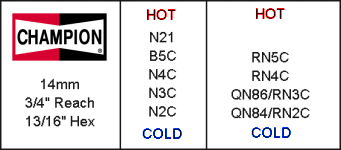
Assuming that everything else about the bike is mechanically in order (!) you
should use a colder plug if your bike suffers from chronic pinking, a hotter
plug if your bike suffers from fouled plugs.
A standard analysis chart of common spark plug problems (courtesy of
Champion):
| Firing End Analysis |
| NORMAL |
OIL FOULED |
CARBON FOULED |
A normal condition is shown
below. This plug has been running at the correct
temperature in a "healthy" engine. Operating in
such a desirable environment results in deposits that will
be light tan or gray in color with most grades of
commercial gasoline.
If LP Gas or natural gas has been used, the color will be
almost brown. |
A spark plug shorted by
excessive oil entering the combustion chamber is shown
below. This is often caused by piston rings or cylinder
walls that are badly worn. Oil may also be pulled into the
chamber because of excessive clearance in the valve stem
guides, or badly worn valve stem seals. If the PCV valve
is plugged or inoperative, it can cause a buildup of
crankcase pressure. This condition can force oil and oil
vapors past the rings and valve guides into the combustion
chamber. |
Basically, soft, sooty
carbon deposits, as shown below, have a dry, black
appearance. If only one or two plugs in a set are fouled,
it is a good practice to check for sticking valves, a
cracked distributor cap, or bad secondary ignition wires.
Fouling of the entire set might result from an incorrect
heat range spark plug or an over-rich air/fuel mixture
caused by a clogged air cleaner filter element, a sticking
heat riser valve, or a faulty choke. Fuel injectors that
malfunction can also lead to this condition.
Other causes include weak ignition
system voltage or an inoperative pre-heating system
(carburetor intake air) or poor cylinder compression.
|
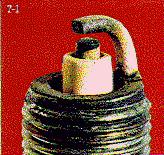 |
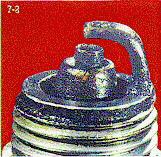 |
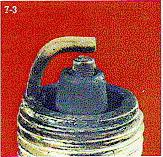 |
|
| WORN |
INSULATOR GLAZING |
MECHANICAL DAMAGE |
| This spark plug shown below
has served its useful life and should be replaced. Voltage
required to fire the plug has approximately doubled and
will continue to increase the longer the engine operates.
Even higher voltage requirements (as
much as 100%) above normal may occur when the engine is
accelerated quickly. Poor engine performance and a loss of
fuel economy are traits of worn spark plugs.
|
This condition may cause
misfiring at high engine RPM. Shiny deposits usually
suggest that temperatures have suddenly increased during
hard acceleration. As a result, normal metallic deposits
do not have a chance to slough off the plug and they melt
and form a conductive coating which causes the misfire.
Yellow or tan deposits, as shown below, usually indicate
the use of leaded fuel. |
Mechanical damage to the
firing end, as shown below, is caused by some foreign
object in the combustion chamber. Since small objects can
travel from one cylinder to another (because of valve
overlap), the other cylinders should always be checked to
prevent reoccurance of damage.
When working on an engine, it is
advisable to keep the carburetor throat (or throttle body
openings on central type fuel injected engines) covered.
That precaution also applies to spark plug holes.
|
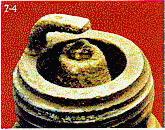 |
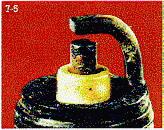 |
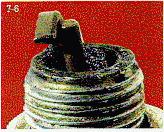 |
|
| OVERHEATED |
SPLASHED FOULED |
ASH FOULED |
| An example of overheating is
shown below. Note the dead white or gray insulator nose
which appears "blistered." Electrode gap wear
rate will be considerably in excess of that normally
expected. This is often caused by overadvanced ignition
timing, poor engine cooling system efficiency (scale,
stoppages, low level), a very lean A/F mixture, a leaking
intake manifold, or the use of a spark plug too hot for
the application. |
Splashed fouling, as shown
below, may sometimes occur after a long-delayed tune-up.
Here, deposits accumulated after long periods of misfiring
or low power operation may be suddenly loosened when
normal combustion temperatures are restored after a set of
new plugs has been installed. During a high-speed run,
these materials shedding off the piston are thrown against
the hot insulator surfaces. |
As shown below, a buildup of
combustion deposits stems primarily from the burning of
oil and/or fuel addatives during normal combustion.
These are normally nonconductive.
However, when heavier deposits are allowed to accumulate
over long mileage periods, they can "mask" the
spark, resulting in a plug misfire condition.
|
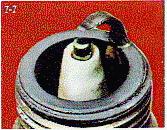 |
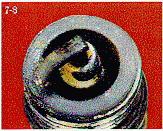 |
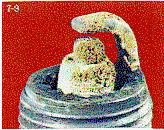 |
|
| GAP BRIDGING |
PREIGNITION |
DETONATION |
| An example of gap bridging
is shown below. It rarely occurs in automotive engines.
Gap bridging is caused by conditions similar to those that
produce splash fouling. Combustion deposits thrown loose
may lodge between the electrodes, causing a dead short and
misfire. Fluffy materials that accumulate on the side
electrode may melt to bridge the gap when the engine is
suddenly put under a heavy load. |
As shown below, this
condition produces melting of the center electrode, and
somewhat later, the ground electrode and insulator.
Usually one or a combination of several engine operating
conditions are the prime causes of pre-ignition. It may
originate from glowing combustion chamber deposits, hot
spots in the combustion chamber due to poor control of
engine heat, cross-firing (electrical induction between
spark plug wires), or the plug heat range is too high for
the engine or its operating conditions. |
As shown below, this form of
abnormal combustion has fractured the insulator nose of
the spark plug. Explosions that occur when the operating
condition exists apply extreme pressure on internal engine
components. Major causes include a faulty EGR valve, lean
air/fuel mixtures, ignition timing advanced too far, and
insufficient octane rating of the gasoline. |
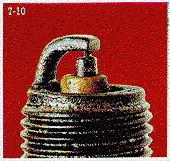 |
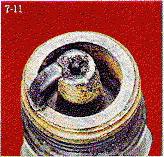 |
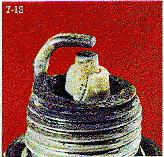 |
|
|
|
Comments or Suggestions? 
© All Content Copyright 1997-2026 Triples Online. All rights reserved.
|
|